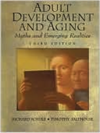Salthouse T. Attrition in Longitudinal Data is Primarily Selective with Respect to Level Rather than Rate of Change. Journal of the International Neuropsychological Society. In Press In Press:1–6.
Publications
In Press
Submitted
Schulz. Salthous (1998). Adult development and aging: Myths and emerging realities. Upper Saddle River, NJ: Prentice Hall; Submitted.
2019
Salthouse TA. Attrition in longitudinal data is primarily selective with respect to level rather than rate of change. Journal of the international Neuropsychological Society. 2019;25(6):618.
Tsapanou HCGYRQSJSYST A. Brain biomarkers and cognition across adulthood. Human Brain Mapping . 2019;40(13):3832–3842.
Siedlecki KL, Falzarano F, Salthouse TA. Examining Gender Differences in Neurocognitive Functioning Across Adulthood. Journal of International Neuropsychological Society . 2019.
Salthouse T. Comparable Consistency, Coherence, and Commonality of Measures of Cognitive Functioning Across Adulthood. Assessment. 2019;26(4):726–736.
Salthouse T. Trajectories of normal cognitive aging.. Psychology and aging. 2019;34 (1):17.
2018
Salthouse T. Why is cognitive change more negative with increased age?. Neuropsychology. 2018;32(1):110.
2017
T.A. S. Contributions of the individual differences approach to cognitive aging. The Journal of Gerontology. 2017:72(1), 7–15.
Reviews three recent contributions of the individudal difference approach: (a) enhancing quality of measurement and investigating equivalence of meaning at difference ages; (b) facilitating the interpretation of measures by specifying how different cognitive measures are related to one another, and (c) distinguishing shared and unique age-related influences on target measures. Makes threee recommendations: (1) obtain multiple measures of the relevant construct instead of relying on a single measure and assuming a one-to-one correspondence between measure and construct; (2) administer a battery of cognitive tests representing major cognitive abilities in addition to the tasks of primary interest to allow general influences to be evaluated and distingushed from specific influences; and (3) employ larger samples of participants.
Soubelet A, Salthouse T. Does need for cognition have the same meaning at different ages?. Assessment. 2017;24(8):987–998.
